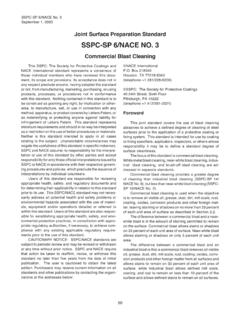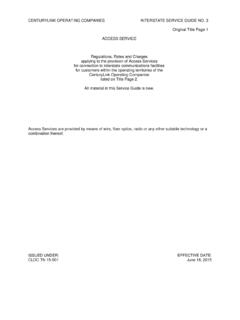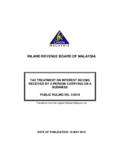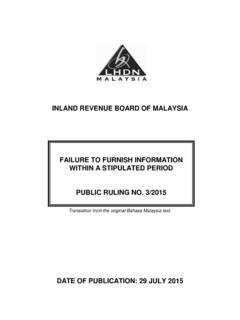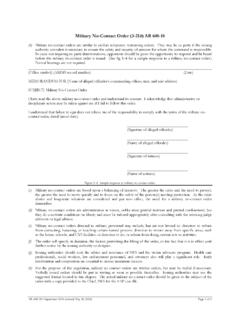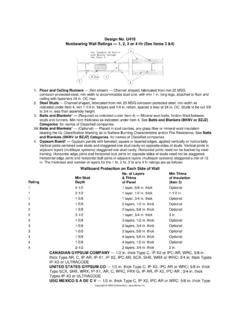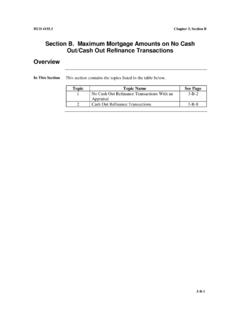Transcription of SPACETRACK REPORT NO. 3 - CelesTrak
1 SPACETRACK REPORT NO. 3. Models for Propagation of NORAD Element Sets Felix R. Hoots Ronald L. Roehrich December 1980. Package Compiled by TS Kelso 31 December 1988. General perturbations element sets generated by NORAD can be used to predict position and ve- locity of Earth-orbiting objects. To do this one must be careful to use a prediction method which is compatible with the way in which the elements were generated. Equations for five compatible models are given here along with corresponding FORTRAN IV computer code. With this informa- tion a user will be able to make satellite predictions which are completely compatible with NORAD.
2 Predictions. i Contents ABSTRACT i CONTENTS ii 1 INTRODUCTION 1. 2 The Propagation Models 1. 3 Compatibility with NORAD Element Sets 2. 4 General Program Description 2. 5 The SGP Model 3. 6 The SGP4 Model 10. 7 The SDP4 Model 21. 8 The SGP8 Model 31. 9 The SDP8 Model 47. 10 The Deep-Space Subroutine 58. 11 Driver and Function Subroutines 69. 12 Users Guide, Constants, and Symbols 76. 13 Sample Test Cases 79. 14 Sample Implementation 85. ACKNOWLEDGEMENTS 86. REFERENCES 87. ii APPROVED FOR PUBLIC RELEASE; DISTRIBUTION UNLIMITED. Requests for additional copies by agencies of the Department of Defense, their contractors, and other government agencies should be directed to the:1.
3 Defense Documentation Center Cameron Station Alexandria VA 22314. All other persons and organizations should apply to the: Department of Commerce National Technical Information Service 5285 Port Royal Road Springfield VA 22161. Address special inquiries to: Project SPACETRACK Reports O ce of Astrodynamics Aerospace Defense Center ADC/DO6. Peterson AFB CO 80914. 1. Editor's note: These are the addresses from the original document and may no longer be valid. iii 1 INTRODUCTION. NORAD maintains general perturbation element sets on all resident space objects. These element sets are periodically refined so as to maintain a reasonable prediction capability on all space objects.
4 In turn, these element sets are provided to users. The purpose of this REPORT is to provide the user with a means of propagating these element sets in time to obtain a position and velocity of the space object. The most important point to be noted is that not just any prediction model will su ce. The NORAD element sets are mean values obtained by removing periodic variations in a particular way. In order to obtain good predictions, these periodic variations must be reconstructed (by the prediction model) in exactly the same way they were removed by NORAD. Hence, inputting NORAD element sets into a di erent model (even though the model may be more accurate or even a numerical integrator) will result in degraded predictions.
5 The NORAD element sets must be used with one of the models described in this REPORT in order to retain maximum prediction accuracy. All space objects are classified by NORAD as near-Earth (period less than 225 minutes) or deep-space (period greater than or equal 225 minutes). Depending on the period, the NORAD. element sets are automatically generated with the near-Earth or deep-space model. The user can then calculate the satellite period and know which prediction model to use. 2 THE PROPAGATION MODELS. Five mathematical models for prediction of satellite position and velocity are available.
6 The first of these, SGP, was developed by Hilton & Kuhlman (1966) and is used for near-Earth satellites. This model uses a simplification of the work of Kozai (1959) for its gravitational model and it takes the drag e ect on mean motion as linear in time. This assumption dictates a quadratic variation of mean anomaly with time. The drag e ect on eccentricity is modeled in such a way that perigee height remains constant. The second model, SGP4, was developed by Ken Cranford in 1970 (see Lane and Hoots 1979). and is used for near-Earth satellites. This model was obtained by simplification of the more extensive analytical theory of Lane and Cranford (1969) which uses the solution of Brouwer (1959).
7 For its gravitational model and a power density function for its atmospheric model (see Lane, et al. 1962). The next model, SDP4, is an extension of SGP4 to be used for deep-space satellites. The deep-space equations were developed by Hujsak (1979) and model the gravitational e ects of the moon and sun as well as certain sectoral and tesseral Earth harmonics which are of particular importance for half-day and one-day period orbits. The SGP8 model (see Hoots 1980) is used for near-Earth satellites and is obtained by simpli- fication of an extensive analytical theory of Hoots (to appear) which uses the same gravitational and atmospheric models as Lane and Cranford did but integrates the di erential equations in a much di erent manner.
8 1. Finally, the SDP8 model is an extension of SGP8 to be used for deep-space satellites. The deep-space e ects are modeled in SDP8 with the same equations used in SDP4. 3 COMPATIBILITY WITH NORAD ELEMENT SETS. The NORAD element sets are currently generated with either SGP4 or SDP4 depending on whether the satellite is near-Earth or deep-space. For element sets sent to external users, the value of mean motion is altered slightly and a pseudo-drag term (n/2). is generated. These changes allow an SGP. user to make compatible predictions in the following manner. If the satellite is near-Earth, then the pseudo-drag term used in SGP simulates the drag e ect of the SGP4 model.
9 If the satellite is deep-space, then the pseudo-drag term used in SGP simulates the deep-space secular e ects of SDP4. For SGP4 and SDP4 users, the mean motion is first recovered from its altered form and the drag e ect is obtained from the SGP4 drag term (B ) with the pseudo-drag term being ignored. The value of the mean motion can be used to determine whether the satellite is near-Earth or deep-space (and hence whether SGP4 or SDP4 was used to generate the element set). From this information the user can decide whether to use SGP4 or SDP4 for propagation and hence be assured of agreement with NORAD predictions.
10 The SGP8 and SDP8 models have the same gravitational and atmospheric models as SGP4. and SDP4, although the form of the solution equations is quite di erent. Additionally, SGP8 and SDP8 use a ballistic coe cient (B term) in the drag equations rather than the B drag term. However, compatible predictions can be made with NORAD element sets by first calculating a B. term from the SGP4 B drag term. At the present time consideration is being given to replacing SGP4 and SDP4 by SGP8 and SDP8 as the NORAD satellite models. In such a case the new NORAD element sets would still give compatible predictions for SGP, SGP4, and SDP4 users and, for SGP8 and SDP8 users, would give agreement with NORAD predictions.

